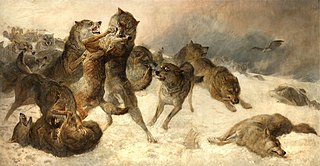
Theoretical ecology is the scientific discipline devoted to the study of ecological systems using theoretical methods such as simple conceptual models, mathematical models, computational simulations, and advanced data analysis. Effective models improve understanding of the natural world by revealing how the dynamics of species populations are often based on fundamental biological conditions and processes. Further, the field aims to unify a diverse range of empirical observations by assuming that common, mechanistic processes generate observable phenomena across species and ecological environments. Based on biologically realistic assumptions, theoretical ecologists are able to uncover novel, non-intuitive insights about natural processes. Theoretical results are often verified by empirical and observational studies, revealing the power of theoretical methods in both predicting and understanding the noisy, diverse biological world.

Thomas Robert Malthus was an English economist, cleric, and scholar influential in the fields of political economy and demography.

A logistic function or logistic curve is a common S-shaped curve with the equation

Exponential growth is a process that increases quantity over time at an ever-increasing rate. It occurs when the instantaneous rate of change of a quantity with respect to time is proportional to the quantity itself. Described as a function, a quantity undergoing exponential growth is an exponential function of time, that is, the variable representing time is the exponent. Exponential growth is the inverse of logarithmic growth.
The Lotka–Volterra equations, also known as the Lotka–Volterra predator–prey model, are a pair of first-order nonlinear differential equations, frequently used to describe the dynamics of biological systems in which two species interact, one as a predator and the other as prey. The populations change through time according to the pair of equations:

Alfred James Lotka was an American mathematician, physical chemist, and statistician, famous for his work in population dynamics and energetics. A biophysicist, Lotka is best known for his proposal of the predator–prey model, developed simultaneously but independently of Vito Volterra. The Lotka–Volterra model is still the basis of many models used in the analysis of population dynamics in ecology.

Pierre François Verhulst was a Belgian mathematician and a doctor in number theory from the University of Ghent in 1825. He is best known for the logistic growth model.
Population dynamics is the type of mathematics used to model and study the size and age composition of populations as dynamical systems.

Mathematical and theoretical biology, or biomathematics, is a branch of biology which employs theoretical analysis, mathematical models and abstractions of living organisms to investigate the principles that govern the structure, development and behavior of the systems, as opposed to experimental biology which deals with the conduction of experiments to test scientific theories. The field is sometimes called mathematical biology or biomathematics to stress the mathematical side, or theoretical biology to stress the biological side. Theoretical biology focuses more on the development of theoretical principles for biology while mathematical biology focuses on the use of mathematical tools to study biological systems, even though the two terms are sometimes interchanged.

Population ecology is a sub-field of ecology that deals with the dynamics of species populations and how these populations interact with the environment, such as birth and death rates, and by immigration and emigration.

Malthusianism is the theory that population growth is potentially exponential, according to the Malthusian growth model, while the growth of the food supply or other resources is linear, which eventually reduces living standards to the point of triggering a population decline. This event, called a Malthusian catastrophe occurs when population growth outpaces agricultural production, causing famine or war, resulting in poverty and depopulation. Such a catastrophe inevitably has the effect of forcing the population to "correct" back to a lower, more easily sustainable level. Malthusianism has been linked to a variety of political and social movements, but almost always refers to advocates of population control.

The book An Essay on the Principle of Population was first published anonymously in 1798, but the author was soon identified as Thomas Robert Malthus. The book warned of future difficulties, on an interpretation of the population increasing in geometric progression while food production increased in an arithmetic progression, which would leave a difference resulting in the want of food and famine, unless birth rates decreased.

An ecosystem model is an abstract, usually mathematical, representation of an ecological system, which is studied to better understand the real system.
A population model is a type of mathematical model that is applied to the study of population dynamics.

A fishery is an area with an associated fish or aquatic population which is harvested for its commercial or recreational value. Fisheries can be wild or farmed. Population dynamics describes the ways in which a given population grows and shrinks over time, as controlled by birth, death, and migration. It is the basis for understanding changing fishery patterns and issues such as habitat destruction, predation and optimal harvesting rates. The population dynamics of fisheries is used by fisheries scientists to determine sustainable yields.
A population is in Malthusian equilibrium when all of its production is used only for subsistence. Malthusian equilibrium is a locally stable and a dynamic equilibrium.
Theory of population may refer to:

The concept of the struggle for existence concerns the competition or battle for resources needed to live. It can refer to human society, or to organisms in nature. The concept is ancient, and the term struggle for existence was in use by the end of the 18th century. From the 17th century onwards the concept was associated with a population exceeding resources, an issue shown starkly in Thomas Robert Malthus’ An Essay on the Principle of Population which drew on Benjamin Franklin's Observations Concerning the Increase of Mankind, Peopling of Countries, etc..

Ecological Orbits: How Planets Move and Populations Grow is a book on population ecology by ecologist Lev R. Ginzburg and philosopher of science Mark Colyvan that argues for an inertial model of population dynamics.














